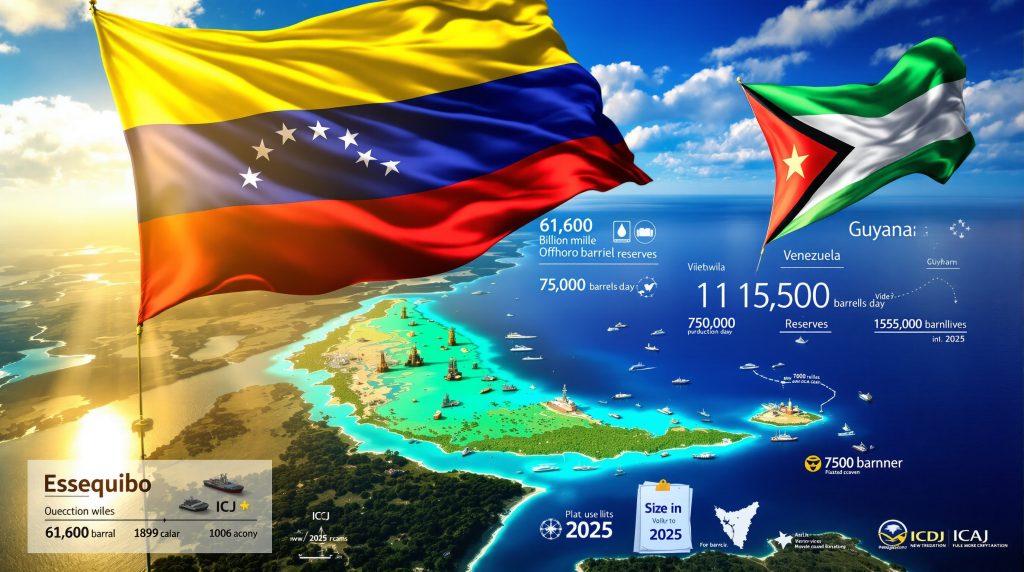The Essequibo territorial dispute stands as one of South America's most volatile geopolitical flashpoints, involving competing sovereignty claims between Venezuela and Guyana over a resource-rich region spanning approximately 61,600 square miles. This contested territory, known as Guayana Esequiba to Venezuela, encompasses nearly two-thirds of Guyana's current landmass and has transformed from a dormant historical disagreement into an active crisis following major offshore oil discoveries.
The dispute centers on a region roughly equivalent to the size of Florida, packed with valuable natural resources including gold, diamonds, bauxite, iron ore, and most significantly, access to offshore petroleum reserves. What began as a colonial boundary disagreement has evolved into a modern territorial conflict with profound implications for regional stability, energy security, and international law, particularly affecting oil price movements across global markets.
How Did the Essequibo Dispute Begin?
Colonial Origins and Early Territorial Claims
The territorial conflict traces its origins to the early 19th century when newly independent Venezuela challenged British colonial boundaries established following the Napoleonic Wars in 1814. After consolidating control over former Dutch territories, Britain merged Essequibo, Demerara, and Berbice into British Guiana in 1831.
Venezuela's initial challenge emerged in 1841, centered on historical arguments that the Essequibo region had originally belonged to the Spanish Viceroyalty of New Granada during the colonial period. This viceroyalty encompassed territories that would later become modern-day Venezuela, Colombia, Panama, and Ecuador, providing the foundation for Venezuela's territorial claims.
The 1899 Paris Arbitral Award
After decades of escalating diplomatic tensions, the dispute was submitted to international arbitration in the late 1800s. The Paris Arbitral Award of 1899 definitively assigned the Essequibo territory to British Guiana, with formal boundary demarcation completed by 1905. This decision remained largely accepted and uncontested until the 1960s.
The arbitration process involved the United States representing Venezuela's interests, despite the eventual ruling favouring British claims. When Guyana's independence from Britain approached in 1962, tensions resurfaced as Venezuela declared the 1899 decision null and void, reigniting a territorial dispute that had remained dormant for over six decades.
Why Has the Dispute Intensified in Recent Years?
The Game-Changing Oil Discoveries
The transformation of this historical territorial disagreement into an active geopolitical crisis began in 2015 when ExxonMobil announced the first of over 30 world-class oil discoveries in the offshore Stabroek Block. These discoveries, containing an estimated 11 billion barrels of crude oil, fundamentally altered the economic stakes involved in the territorial dispute.
| Milestone | Year | Significance |
|---|---|---|
| First major discovery | 2015 | ExxonMobil announces initial find |
| First oil production | 2019 | Record 4-year development timeline |
| Current production | 2024 | 750,000 barrels per day |
| Regional ranking | 2024 | South America's fourth-largest oil producer |
The 6.6-million-acre Stabroek Block represents one of the most significant petroleum discoveries of the 21st century. Remarkably, Guyana achieved the transition from first discovery to commercial production in just four years, compared to the typical industry standard of a decade or longer for major oilfield development.
Current production of 750,000 barrels per day has positioned Guyana as South America's fourth-largest oil producer, surpassing Colombia and trailing only Brazil, Argentina, and Venezuela. This rapid ascension from one of the region's poorest nations to a major petroleum exporter has created powerful economic incentives for territorial control.
Venezuela's Economic Desperation
Venezuela's escalation of territorial claims directly correlates with the country's severe economic collapse. Despite possessing the world's largest proven oil reserves at over 303 billion barrels, decades of mismanagement following Hugo Chavez's 1999 Bolivarian Revolution have devastated the nation's petroleum industry and broader economy.
The economic crisis has left over 90% of Venezuela's population living in poverty, creating desperate conditions that have driven millions to emigrate. Endemic corruption, infrastructure decay, and international sanctions have rendered Venezuela's vast oil wealth largely inaccessible, making the prospect of controlling Guyana's readily accessible petroleum reserves increasingly attractive.
Key Economic Factors:
- Venezuela's oil production capacity severely diminished due to infrastructure collapse
- International sanctions limiting Venezuela's ability to monetise existing reserves
- Political instability requiring external distractions to maintain regime legitimacy
- Geographic proximity making Essequibo an accessible target for territorial expansion
What Actions Has Venezuela Taken to Assert Its Claims?
Military Infrastructure Development
Since 2023, Venezuela has undertaken comprehensive military preparations along the Guyanese border, including construction of new military bases, airstrips, and support infrastructure. These developments represent the most significant military buildup in the region in decades, demonstrating Venezuela's serious intent to back territorial claims with military capability.
Military Deployment Activities:
- Construction of permanent military installations and airfields
- Deployment of National Bolivarian Armed Forces units to border regions
- Regular border probes and harassment of civilian installations
- Naval incursions into Guyanese territorial waters
- Intelligence gathering operations targeting Guyanese defence capabilities
Political and Legal Manoeuvres
President Nicolás Maduro's administration has implemented a systematic campaign to legitimise Venezuelan territorial claims through political and legal mechanisms designed to create a framework for potential annexation.
| Action | Date | Claimed Result | Purpose |
|---|---|---|---|
| Constitutional referendum | December 2023 | 95.9% support (low turnout) | Popular mandate for annexation |
| Creation of Guayana Esequiba state | 2024 | Administrative framework established | Governmental structure |
| Symbolic elections | May 2025 | Venezuelan officials appointed | Representative legitimacy |
| PDVSA licensing | Ongoing | Oil exploration permits granted | Economic jurisdiction |
The December 2023 referendum, while claiming overwhelming support, suffered from apparently poor voter turnout, raising questions about its legitimacy. Nevertheless, Maduro utilised the results to implement subsequent measures including issuing national identity cards to Essequibo residents, declaring the region a military zone, and granting petroleum exploration licenses to state-owned PDVSA.
Naval Confrontations
The most serious military incident occurred on March 1, 2025, when Venezuelan gunboat ABF Guaiqueri PO-11 entered Guyana's exclusive economic zone. This armed vessel, equipped with a 76mm cannon, 35mm Oerlikon weapon system, and two 12.7mm machine guns, directly confronted ExxonMobil's offshore petroleum operations.
Technical Details of the Confrontation:
- Vessel: ABF Guaiqueri PO-11 (Venezuelan Navy patrol boat)
- Location: Stabroek Block within Guyana's exclusive economic zone
- Targets: ExxonMobil's FPSO vessels (Liza Destiny, Liza Unity, and Prosperity)
- Actions: Crew interrogation and territorial warnings
- Duration: Several hours of direct confrontation
The incident represented the most direct military challenge to Guyana's sovereignty and demonstrated Venezuela's willingness to use naval assets to intimidate international petroleum operations. Venezuelan naval personnel warned ExxonMobil crews they were operating in Venezuelan waters, directly challenging established international boundaries.
How Has Guyana Responded to Venezuelan Aggression?
International Legal Strategy
Guyana has pursued a comprehensive diplomatic and legal approach to counter Venezuelan territorial claims, leveraging international institutions and regional partnerships to defend its sovereignty. The strategy focuses on multilateral support and legal validation of existing boundaries.
Legal and Diplomatic Initiatives:
- International Court of Justice (ICJ): Filed comprehensive case in 2018
- ICJ Jurisdiction Ruling: Court confirmed authority to hear the dispute in 2023
- Organisation of American States (OAS): Sought multilateral support for territorial integrity
- CARICOM Support: Secured unanimous Caribbean Community backing
President Irfaan Ali's administration has maintained a firm position on territorial integrity, with the president stating unequivocally that the Essequibo region is not subject to negotiation or compromise. This stance reflects both legal confidence in Guyana's position and recognition that any territorial concessions would undermine national sovereignty.
Military Preparedness
Despite possessing fewer than 5,000 defence personnel, Guyana has responded to Venezuelan military threats through strategic mobilisation of available assets and enhanced cooperation with regional partners. The country's limited military capacity necessitates reliance on deterrence and international support rather than direct confrontation.
Defence Response Measures:
- Mobilisation of air assets and coast guard vessels during confrontations
- Increased border patrol frequency and surveillance operations
- Enhanced intelligence sharing with Brazilian military forces
- Coordination with U.S. Southern Command for security cooperation
- Investment in early warning systems and defensive capabilities
Furthermore, the situation mirrors other resource-related conflicts worldwide, including the recent Namibia uranium halt which demonstrates how territorial tensions can affect critical mineral extraction operations.
Strategic Partnerships
Recognising its military limitations, Guyana has actively cultivated security partnerships, particularly with the United States. These relationships aim to provide deterrent effect against Venezuelan aggression while building long-term defensive capabilities.
Partnership Development:
- July 2023: President Ali met with U.S. Secretary of State Antony Blinken
- September 2025: Continued high-level meetings with U.S. Secretary of State Marco Rubio
- Focus Areas: Military cooperation, equipment modernisation, training programmes
- Strategic Goal: Enhanced deterrence through international security assurances
What Role Does the United States Play in This Dispute?
Security Assurances and Military Cooperation
The Trump administration's deployment of U.S. warships off Venezuela's coast represents the most significant American military involvement in the region in recent years. This "gunboat diplomacy" approach demonstrates substantial U.S. commitment to supporting Guyana's territorial integrity against Venezuelan aggression, particularly in light of the critical minerals order that emphasises securing strategic resource supplies.
U.S. Military and Diplomatic Support:
- Naval presence in regional waters as deterrent force
- Enhanced cooperation between Guyana Defence Force and U.S. Southern Command
- High-level diplomatic meetings reinforcing security partnerships
- Security assistance and military training programme development
- Intelligence sharing and early warning system support
The strategic relationship extends beyond immediate crisis management to long-term capacity building. American military advisors are working with Guyanese defence officials to modernise equipment, improve training programmes, and enhance overall defensive capabilities against potential Venezuelan invasion.
Economic Interests
American energy companies, particularly ExxonMobil, have invested billions of dollars in Guyanese offshore petroleum operations, creating substantial U.S. economic interests in maintaining regional stability. These investments represent some of the most significant American commercial commitments in South America, linking energy security with territorial integrity.
Economic Stakes:
- Multi-billion dollar ExxonMobil investments in Stabroek Block development
- Established petroleum export infrastructure and supply chains
- Long-term production sharing agreements with Guyanese government
- Strategic importance for U.S. energy diversification goals
The protection of these economic interests aligns with broader U.S. strategic objectives in countering authoritarian regimes and supporting democratic allies in Latin America. Venezuela's threats against American petroleum operations directly challenge U.S. commercial interests and regional influence.
What Are the Broader Regional Implications?
Brazil's Strategic Position
Brazil has emerged as a crucial regional mediator and intelligence provider, offering unique perspectives on Venezuelan military preparations and territorial ambitions. Brazilian military intelligence warned of Venezuela's military readiness for potential strikes on Essequibo in 2023, providing critical early warning to both Guyana and international partners.
Brazilian Involvement:
- Military intelligence sharing on Venezuelan troop movements and preparations
- Increased border security presence as deterrent measure
- Diplomatic support for peaceful resolution mechanisms
- Regional mediation efforts between competing parties
Brazil's position reflects both geographic proximity and broader concerns about regional stability. As South America's largest nation, Brazil has vital interests in preventing territorial conflicts that could destabilise the continent and create refugee crises or economic disruption.
Caribbean Community Response
CARICOM nations have unanimously supported Guyana's territorial integrity, viewing Venezuelan aggression as a threat to small-state sovereignty principles throughout the Caribbean region. This solidarity reflects shared concerns about larger neighbours using military pressure to intimidate smaller nations.
The Caribbean response demonstrates how territorial disputes can affect regional security architectures, with small island nations recognising that Venezuelan success in seizing Essequibo could establish dangerous precedents for future territorial aggression throughout the region.
Energy Market Impacts
The territorial dispute affects global energy markets through multiple channels, creating uncertainty about one of the world's most promising new petroleum provinces. Guyana's rapid emergence as South America's fourth-largest oil producer makes territorial stability crucial for international energy security, particularly amid broader concerns about tariff policy impact on global trade.
Market Implications:
- Production Risk: Threats to Guyana's 750,000 barrels per day output
- Investment Climate: Potential deterrent effect on future exploration activities
- Supply Chain Disruption: Risk to established petroleum export routes
- Price Volatility: Market reactions to escalating territorial tensions
What Does the Future Hold for the Essequibo Territorial Dispute?
ICJ Proceedings Timeline
The International Court of Justice continues hearing arguments on the substantive merits of the territorial case, though a final ruling may still be years away. Venezuela's non-recognition of ICJ jurisdiction significantly complicates enforcement prospects, even if the court rules definitively in Guyana's favour.
The legal timeline creates ongoing uncertainty, as territorial disputes of this complexity typically require extensive evidence review, expert testimony, and deliberation periods. Historical precedent suggests ICJ territorial cases often take 5-10 years from filing to final resolution.
Economic Development Pressures
Guyana's transformation into a major petroleum producer creates powerful economic incentives for both countries that may either intensify the conflict or provide pathways toward resolution through resource-sharing arrangements. The situation reflects broader global mining dynamics where resource discoveries can reshape geopolitical relationships.
Competing Economic Pressures:
- For Guyana: Protecting newfound petroleum wealth essential for national development
- For Venezuela: Accessing resources crucial for alleviating severe economic crisis
- For International Partners: Maintaining investment security and supply stability
- Regional Impact: Economic benefits or disruption affecting neighbouring countries
Potential Resolution Mechanisms
Several pathways could lead to dispute resolution, though each faces significant challenges and requires fundamental shifts in current positions.
| Resolution Path | Likelihood | Key Requirements | Timeline |
|---|---|---|---|
| ICJ binding decision | Medium | Venezuelan acceptance of ruling | 3-7 years |
| Bilateral negotiation | Low | Major Venezuelan position change | 1-2 years |
| International mediation | Medium | Sustained diplomatic pressure | 2-5 years |
| Status quo maintenance | High | Continued deterrent effectiveness | Indefinite |
The most likely scenario involves maintenance of current territorial boundaries through continued international deterrence, though this creates ongoing instability and resource uncertainty. Venezuelan economic desperation may eventually force consideration of alternative approaches, including potential resource-sharing agreements that provide economic benefits without territorial concessions.
Why Should the International Community Care?
Precedent for Territorial Disputes
The Essequibo territorial dispute establishes crucial precedents for how historical territorial claims are adjudicated in the modern era, particularly when significant natural resources are involved. The international community's response will influence future territorial conflicts worldwide.
Global Implications:
- Standards for challenging historical boundary settlements
- Role of resource discoveries in reviving dormant territorial claims
- Effectiveness of international legal institutions in resolving disputes
- Balance between historical claims and established sovereignty
Energy Security Implications
Guyana's emergence as a major petroleum producer affects global energy supply diversity and provides alternatives to traditional sources. Territorial stability directly impacts international energy markets and supply chain security for multiple countries.
The Stabroek Block's 11 billion barrels represent a significant portion of recent global petroleum discoveries, making the region's stability crucial for energy companies, importing nations, and global price stability. Any disruption to Guyanese production would reverberate through international energy markets.
Small State Sovereignty
The dispute tests international commitment to protecting small nations against larger neighbours' territorial ambitions, with implications extending far beyond South America. Success or failure in defending Guyana's sovereignty will influence similar conflicts worldwide.
Broader Sovereignty Principles:
- Protection of small states against military intimidation
- Effectiveness of international law in territorial disputes
- Role of great powers in regional security provision
- Balance between historical claims and current sovereignty
The international community's response to Venezuelan territorial aggression will establish precedents for protecting small nations throughout Africa, Asia, and the Pacific, where similar territorial pressures exist from larger neighbours seeking to exploit resource discoveries or strategic advantages.
Consequently, the ongoing tensions in the Essequibo dispute represent a critical test of international law, regional stability, and energy security in an interconnected world. As Venezuela's economic crisis deepens and Guyana's petroleum wealth grows, the stakes continue rising for all parties involved. The resolution of this conflict will shape territorial dispute precedents and regional power dynamics for decades to come.
Interested in the Next Major Mineral Discovery?
Discovery Alert instantly identifies significant ASX mineral discoveries using its proprietary Discovery IQ model, transforming complex geological data into actionable investment insights ahead of the market. Explore historic examples of exceptional returns from major discoveries, then begin your 30-day free trial to position yourself at the forefront of Australia's resource sector opportunities.




